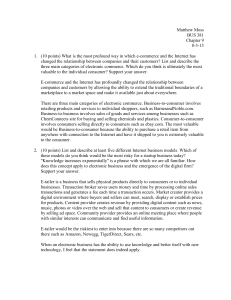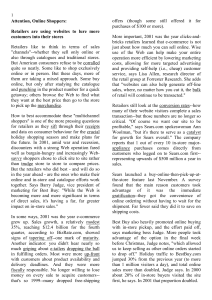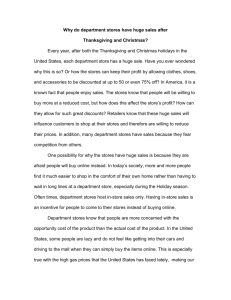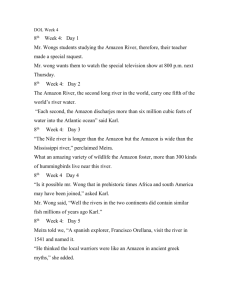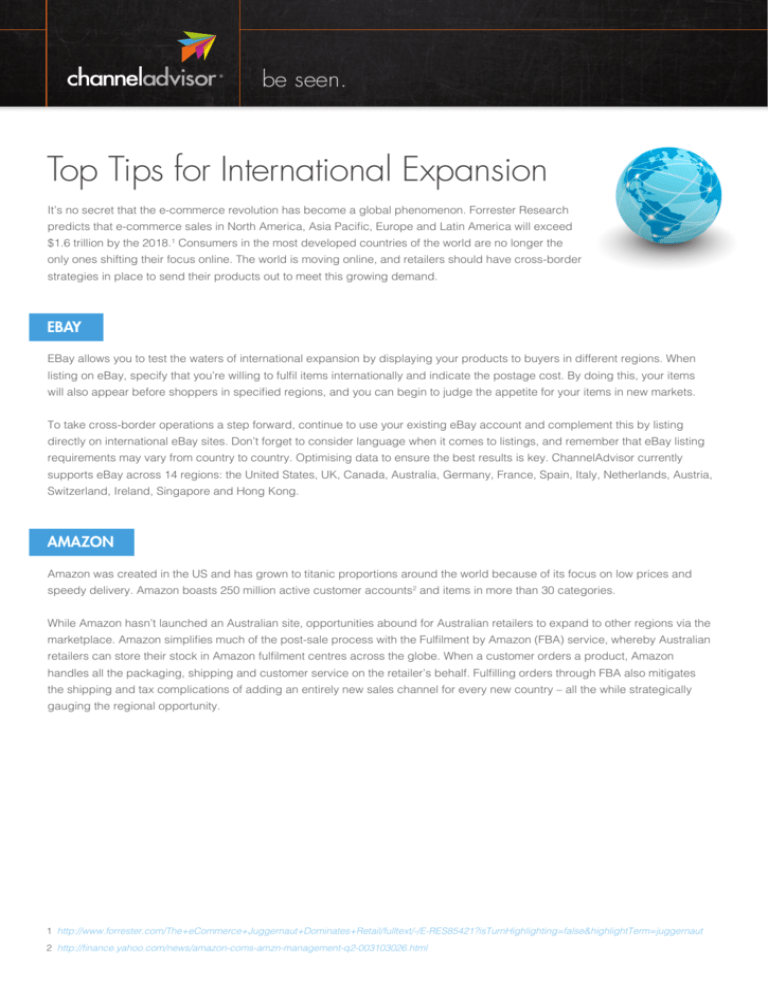
be seen.
Top Tips for International Expansion
It’s no secret that the e-commerce revolution has become a global phenomenon. Forrester Research
predicts that e-commerce sales in North America, Asia Pacific, Europe and Latin America will exceed
$1.6 trillion by the 2018.1 Consumers in the most developed countries of the world are no longer the
only ones shifting their focus online. The world is moving online, and retailers should have cross-border
strategies in place to send their products out to meet this growing demand.
EBAY
EBay allows you to test the waters of international expansion by displaying your products to buyers in different regions. When
listing on eBay, specify that you’re willing to fulfil items internationally and indicate the postage cost. By doing this, your items
will also appear before shoppers in specified regions, and you can begin to judge the appetite for your items in new markets.
To take cross-border operations a step forward, continue to use your existing eBay account and complement this by listing
directly on international eBay sites. Don’t forget to consider language when it comes to listings, and remember that eBay listing
requirements may vary from country to country. Optimising data to ensure the best results is key. ChannelAdvisor currently
supports eBay across 14 regions: the United States, UK, Canada, Australia, Germany, France, Spain, Italy, Netherlands, Austria,
Switzerland, Ireland, Singapore and Hong Kong.
AMAZON
Amazon was created in the US and has grown to titanic proportions around the world because of its focus on low prices and
speedy delivery. Amazon boasts 250 million active customer accounts2 and items in more than 30 categories.
While Amazon hasn’t launched an Australian site, opportunities abound for Australian retailers to expand to other regions via the
marketplace. Amazon simplifies much of the post-sale process with the Fulfilment by Amazon (FBA) service, whereby Australian
retailers can store their stock in Amazon fulfilment centres across the globe. When a customer orders a product, Amazon
handles all the packaging, shipping and customer service on the retailer’s behalf. Fulfilling orders through FBA also mitigates
the shipping and tax complications of adding an entirely new sales channel for every new country – all the while strategically
gauging the regional opportunity.
1 http://www.forrester.com/The+eCommerce+Juggernaut+Dominates+Retail/fulltext/-/E-RES85421?isTurnHighlighting=false&highlightTerm=juggernaut
2 http://finance.yahoo.com/news/amazon-coms-amzn-management-q2-003103026.html
LANGUAGE
Translation should be at the core of your expansion plans. Forrester Research notes that the e-commerce markets of Europe,
Latin America and Asia Pacific will continue to experience double-digit growth each year from 2013 to 2018, based on the
convenience, value and selection that online shopping provides to consumers.3
These figures reveal that listing your products in English limits your reach to a wider audience of ready buyers. Despite the great
opportunity, translation is one of the largest challenges retailers encounter when expanding across borders. Advertising to new
regions, particularly on marketplaces, requires your listing details (e.g., product title, description) to be translated into the local
language. Spending the time to get your data properly translated will ensure you reach those customers with optimal clarity and
avoid the erosion of trust that results from common machine translation errors.
TAX
With adoption rates of online shopping booming globally and customers open to international purchases, retailers have
found themselves breaching tax requirements in an eager effort to reach those markets. The first rule when handling taxes
internationally is to be cautious and know your tax thresholds before entering a market. If there’s anything you’re not clear on,
speak to a tax expert who can address your specific situation. Be aware that value-added tax (VAT) or goods and services tax
(GST) rates and regulations vary by country, along with which party is responsible for paying the taxes. Becoming knowledgeable
in the tax requirements of each region prior to launch will ensure you can sell with fewer complications.
FULFILMENT
With the rise of mobile, tablet and even social commerce, consumers continue to adopt an “anytime, anywhere” approach to
purchasing products. The evolution of these channels has increased pressure on retailers’ fulfilment strategies, as consumers
expect the same flexible, efficient shipping options and results for orders. Inventory data is king when it comes to fulfilment. It’s
vital that products listed online are both in stock and described correctly. To ease the burden and prevent errors, consider using
Amazon Global FBA or a third-party fulfilment company instead of acquiring multiple contracts with various logistics services.
CUSTOMER SERVICE
Just like selling domestically, building trust with your audience is key to sustained success when selling across borders, and
the post-purchase customer experience must be considered prior to the execution of expansion strategies. Do you have a
multilingual support team? Do you understand the cultural nuances of the audience? How will you handle returns? Identifying
challenges and devising solutions ahead of time will not only ensure a smooth sales funnel, but it will also ensure happy and
loyal return customers.
For more information on how ChannelAdvisor can help you expand your e-commerce business
across borders, email us at ausales@channeladvisor.com or call 1300 887 239.
3 http://www.forrester.com/The+eCommerce+Juggernaut+Dominates+Retail/fulltext/-/E-RES85421?isTurnHighlighting=false&highlightTerm=juggernaut
Copyright 2015 ChannelAdvisor Corporation. All rights reserved.
1300 887 239
|
www.channeladvisor.com.au
|
ausales@channeladvisor.com

